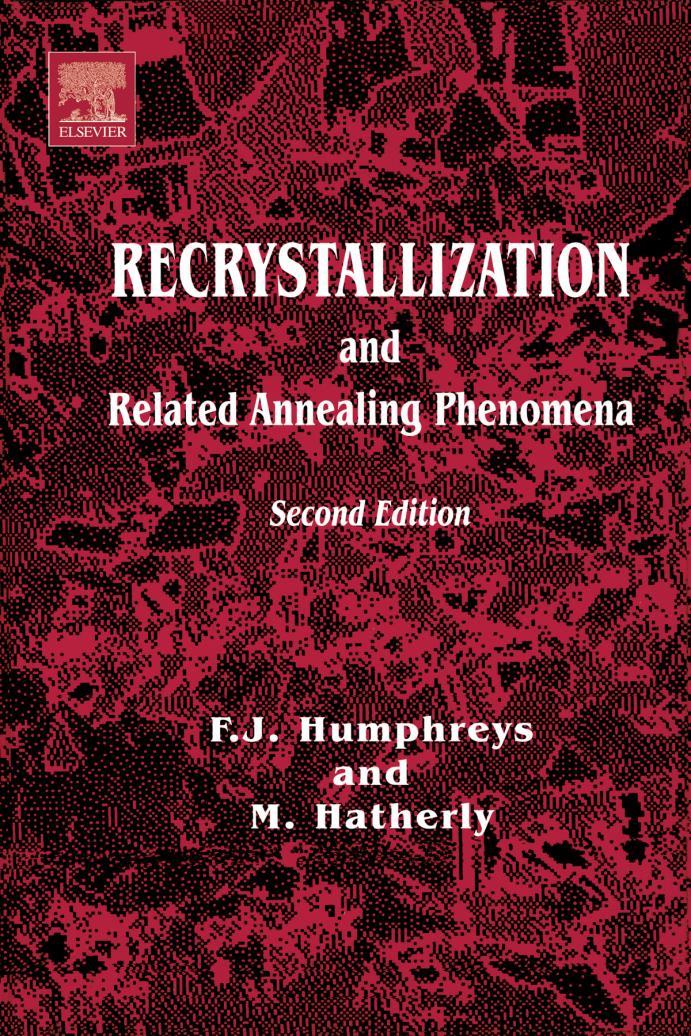
ELSEVIER RECRYSTALLIZATION and Related Annealing Phenomena 数烤 03a Second Edition M.Hatherly
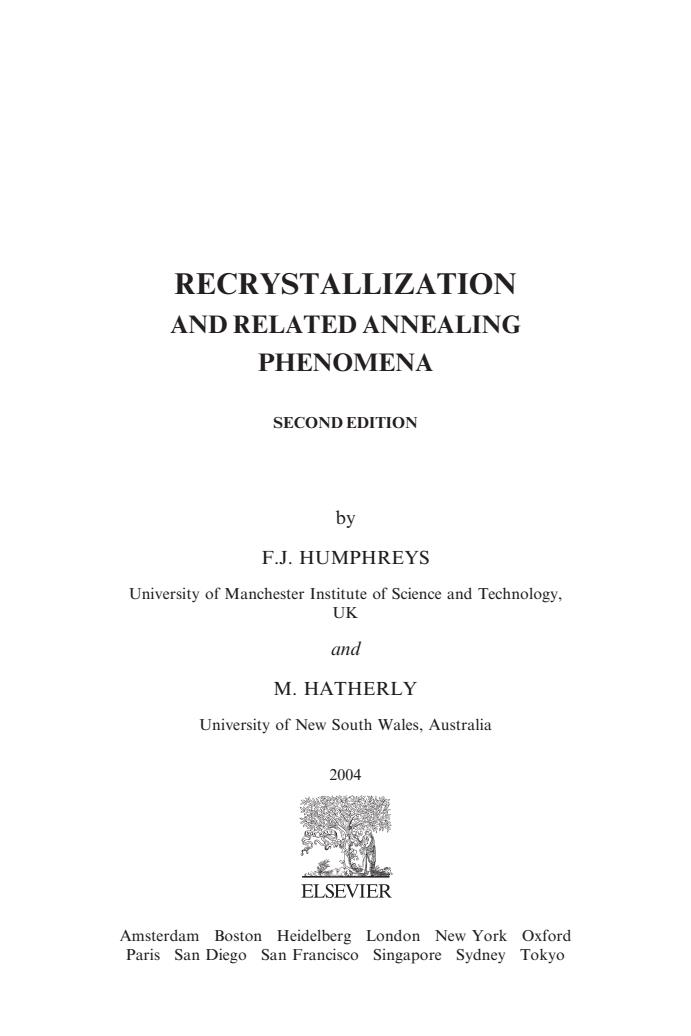
RECRYSTALLIZATION AND RELATED ANNEALING PHENOMENA SECOND EDITION by F.J.HUMPHREYS University of Manchester Institute of Science and Technology, UK and M.HATHERLY University of New South Wales,Australia 2004 山吃 ELSEVIER Amsterdam Boston Heidelberg London New York Oxford Paris San Diego San Francisco Singapore Sydney Tokyo
RECRYSTALLIZATION AND RELATED ANNEALING PHENOMENA SECOND EDITION by F.J. HUMPHREYS University of Manchester Institute of Science and Technology, UK and M. HATHERLY University of New South Wales, Australia 2004 Amsterdam Boston Heidelberg London New York Oxford Paris San Diego San Francisco Singapore Sydney Tokyo
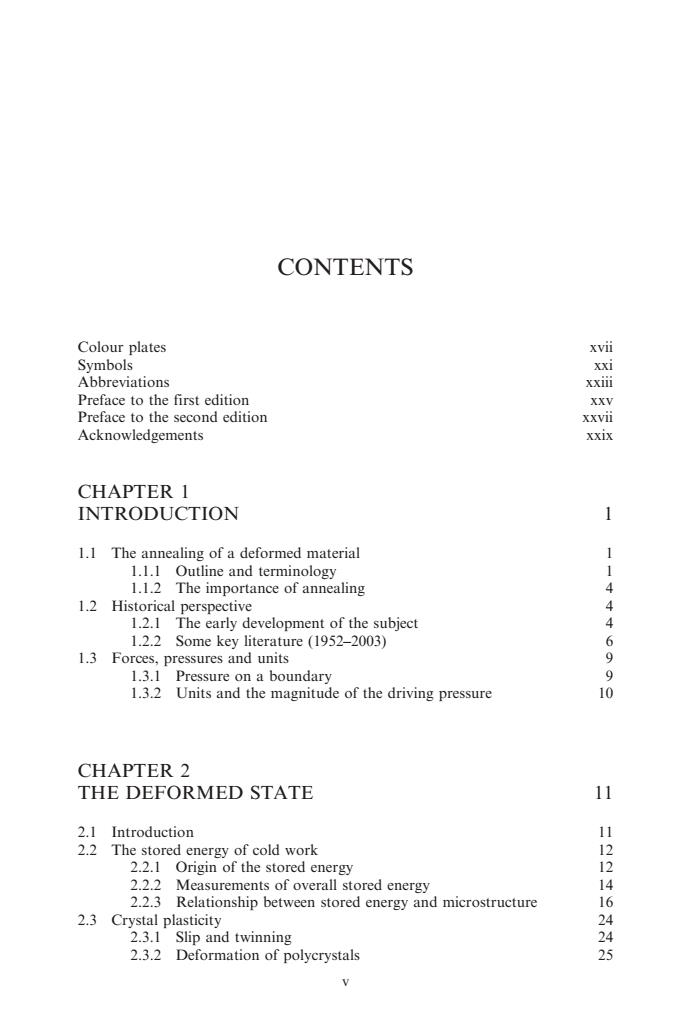
CONTENTS Colour plates xvii Symbols XXi Abbreviations xxiii Preface to the first edition XXV Preface to the second edition xxvii Acknowledgements XXiX CHAPTER 1 INTRODUCTION 1 1.1 The annealing of a deformed material 1 1.1.1 Outline and terminology 1 1.1.2 The importance of annealing 4 1.2 Historical perspective 4 1.2.1 The early development of the subject 4 1.2.2 Some key literature(1952-2003) 6 1.3 Forces,pressures and units 9 1.3.1 Pressure on a boundary 9 1.3.2 Units and the magnitude of the driving pressure 10 CHAPTER 2 THE DEFORMED STATE 11 2.1 Introduction 11 2.2 The stored energy of cold work 12 2.2.1 Origin of the stored energy 12 2.2.2 Measurements of overall stored energy 14 2.2.3 Relationship between stored energy and microstructure 16 2.3 Crystal plasticity 24 2.3.1 Slip and twinning 24 2.3.2 Deformation of polycrystals 25
CONTENTS Colour plates xvii Symbols xxi Abbreviations xxiii Preface to the first edition xxv Preface to the second edition xxvii Acknowledgements xxix CHAPTER 1 INTRODUCTION 1 1.1 The annealing of a deformed material 1 1.1.1 Outline and terminology 1 1.1.2 The importance of annealing 4 1.2 Historical perspective 4 1.2.1 The early development of the subject 4 1.2.2 Some key literature (1952–2003) 6 1.3 Forces, pressures and units 9 1.3.1 Pressure on a boundary 9 1.3.2 Units and the magnitude of the driving pressure 10 CHAPTER 2 THE DEFORMED STATE 11 2.1 Introduction 11 2.2 The stored energy of cold work 12 2.2.1 Origin of the stored energy 12 2.2.2 Measurements of overall stored energy 14 2.2.3 Relationship between stored energy and microstructure 16 2.3 Crystal plasticity 24 2.3.1 Slip and twinning 24 2.3.2 Deformation of polycrystals 25 v
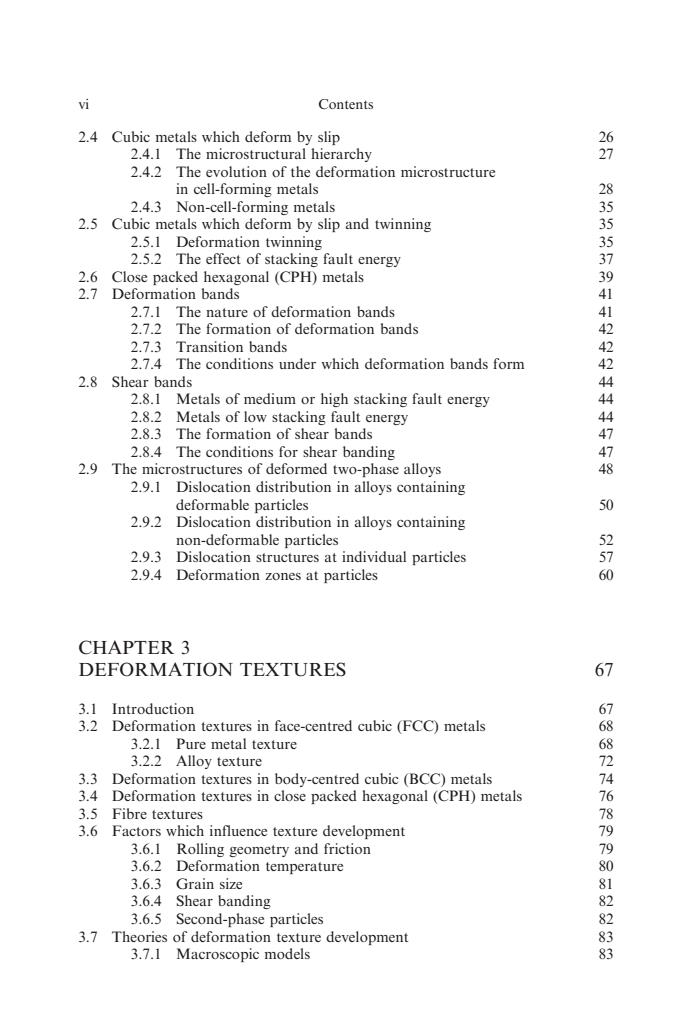
vi Contents 2.4 Cubic metals which deform by slip 26 2.4.1 The microstructural hierarchy 27 2.4.2 The evolution of the deformation microstructure in cell-forming metals 28 2.4.3 Non-cell-forming metals 35 2.5 Cubic metals which deform by slip and twinning 35 2.5.1 Deformation twinning 35 2.5.2 The effect of stacking fault energy 37 2.6 Close packed hexagonal (CPH)metals 39 2.7 Deformation bands 41 2.7.1 The nature of deformation bands 41 2.7.2 The formation of deformation bands 42 2.7.3 Transition bands 42 2.7.4 The conditions under which deformation bands form 42 2.8 Shear bands 44 2.8.1 Metals of medium or high stacking fault energy 44 2.8.2 Metals of low stacking fault energy 44 2.8.3 The formation of shear bands 47 2.8.4 The conditions for shear banding 47 2.9 The microstructures of deformed two-phase alloys 48 2.9.1 Dislocation distribution in alloys containing deformable particles 50 2.9.2 Dislocation distribution in alloys containing non-deformable particles 52 2.9.3 Dislocation structures at individual particles 57 2.9.4 Deformation zones at particles 60 CHAPTER 3 DEFORMATION TEXTURES 67 3.1 Introduction 67 3.2 Deformation textures in face-centred cubic (FCC)metals 68 3.2.1 Pure metal texture 68 3.2.2 Alloy texture 72 3.3 Deformation textures in body-centred cubic (BCC)metals 74 3.4 Deformation textures in close packed hexagonal(CPH)metals 76 3.5 Fibre textures 78 3.6 Factors which influence texture development 79 3.6.1 Rolling geometry and friction 79 3.6.2 Deformation temperature 80 3.6.3 Grain size 81 3.6.4 Shear banding 2 3.6.5 Second-phase particles 82 3.7 Theories of deformation texture development 8 3.7.1 Macroscopic models
2.4 Cubic metals which deform by slip 26 2.4.1 The microstructural hierarchy 27 2.4.2 The evolution of the deformation microstructure in cell-forming metals 28 2.4.3 Non-cell-forming metals 35 2.5 Cubic metals which deform by slip and twinning 35 2.5.1 Deformation twinning 35 2.5.2 The effect of stacking fault energy 37 2.6 Close packed hexagonal (CPH) metals 39 2.7 Deformation bands 41 2.7.1 The nature of deformation bands 41 2.7.2 The formation of deformation bands 42 2.7.3 Transition bands 42 2.7.4 The conditions under which deformation bands form 42 2.8 Shear bands 44 2.8.1 Metals of medium or high stacking fault energy 44 2.8.2 Metals of low stacking fault energy 44 2.8.3 The formation of shear bands 47 2.8.4 The conditions for shear banding 47 2.9 The microstructures of deformed two-phase alloys 48 2.9.1 Dislocation distribution in alloys containing deformable particles 50 2.9.2 Dislocation distribution in alloys containing non-deformable particles 52 2.9.3 Dislocation structures at individual particles 57 2.9.4 Deformation zones at particles 60 CHAPTER 3 DEFORMATION TEXTURES 67 3.1 Introduction 67 3.2 Deformation textures in face-centred cubic (FCC) metals 68 3.2.1 Pure metal texture 68 3.2.2 Alloy texture 72 3.3 Deformation textures in body-centred cubic (BCC) metals 74 3.4 Deformation textures in close packed hexagonal (CPH) metals 76 3.5 Fibre textures 78 3.6 Factors which influence texture development 79 3.6.1 Rolling geometry and friction 79 3.6.2 Deformation temperature 80 3.6.3 Grain size 81 3.6.4 Shear banding 82 3.6.5 Second-phase particles 82 3.7 Theories of deformation texture development 83 3.7.1 Macroscopic models 83 vi Contents
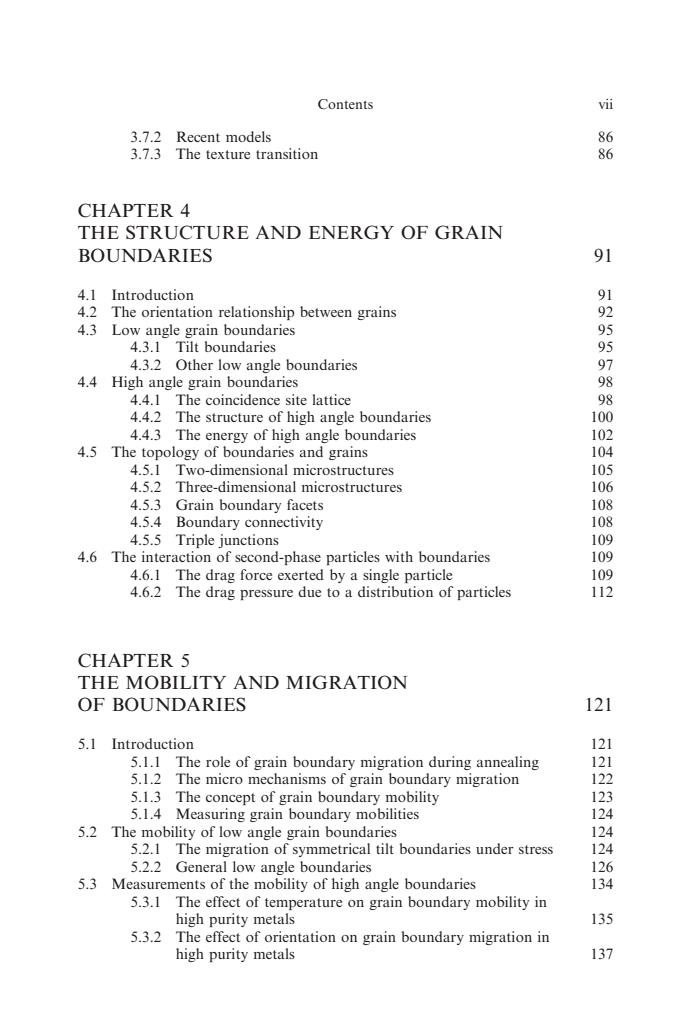
Contents vii 3.7.2 Recent models 86 3.7.3 The texture transition 86 CHAPTER 4 THE STRUCTURE AND ENERGY OF GRAIN BOUNDARIES 91 4.1 Introduction 91 4.2 The orientation relationship between grains 92 4.3 Low angle grain boundaries 95 4.3.1 Tilt boundaries 95 4.3.2 Other low angle boundaries 97 4.4 High angle grain boundaries 98 4.4.1 The coincidence site lattice 98 4.4.2 The structure of high angle boundaries 100 4.4.3 The energy of high angle boundaries 102 4.5 The topology of boundaries and grains 104 4.5.1 Two-dimensional microstructures 105 4.5.2 Three-dimensional microstructures 106 4.5.3 Grain boundary facets 108 4.5.4 Boundary connectivity 108 4.5.5 Triple junctions 109 4.6 The interaction of second-phase particles with boundaries 109 4.6.1 The drag force exerted by a single particle 109 4.6.2 The drag pressure due to a distribution of particles 112 CHAPTER 5 THE MOBILITY AND MIGRATION OF BOUNDARIES 121 5.1 Introduction 121 5.1.1 The role of grain boundary migration during annealing 121 5.1.2 The micro mechanisms of grain boundary migration 122 5.1.3 The concept of grain boundary mobility 123 5.1.4 Measuring grain boundary mobilities 124 5.2 The mobility of low angle grain boundaries 124 5.2.1 The migration of symmetrical tilt boundaries under stress 124 5.2.2 General low angle boundaries 126 5.3 Measurements of the mobility of high angle boundaries 134 5.3.1 The effect of temperature on grain boundary mobility in high purity metals 135 5.3.2 The effect of orientation on grain boundary migration in high purity metals 137
3.7.2 Recent models 86 3.7.3 The texture transition 86 CHAPTER 4 THE STRUCTURE AND ENERGY OF GRAIN BOUNDARIES 91 4.1 Introduction 91 4.2 The orientation relationship between grains 92 4.3 Low angle grain boundaries 95 4.3.1 Tilt boundaries 95 4.3.2 Other low angle boundaries 97 4.4 High angle grain boundaries 98 4.4.1 The coincidence site lattice 98 4.4.2 The structure of high angle boundaries 100 4.4.3 The energy of high angle boundaries 102 4.5 The topology of boundaries and grains 104 4.5.1 Two-dimensional microstructures 105 4.5.2 Three-dimensional microstructures 106 4.5.3 Grain boundary facets 108 4.5.4 Boundary connectivity 108 4.5.5 Triple junctions 109 4.6 The interaction of second-phase particles with boundaries 109 4.6.1 The drag force exerted by a single particle 109 4.6.2 The drag pressure due to a distribution of particles 112 CHAPTER 5 THE MOBILITY AND MIGRATION OF BOUNDARIES 121 5.1 Introduction 121 5.1.1 The role of grain boundary migration during annealing 121 5.1.2 The micro mechanisms of grain boundary migration 122 5.1.3 The concept of grain boundary mobility 123 5.1.4 Measuring grain boundary mobilities 124 5.2 The mobility of low angle grain boundaries 124 5.2.1 The migration of symmetrical tilt boundaries under stress 124 5.2.2 General low angle boundaries 126 5.3 Measurements of the mobility of high angle boundaries 134 5.3.1 The effect of temperature on grain boundary mobility in high purity metals 135 5.3.2 The effect of orientation on grain boundary migration in high purity metals 137 Contents vii